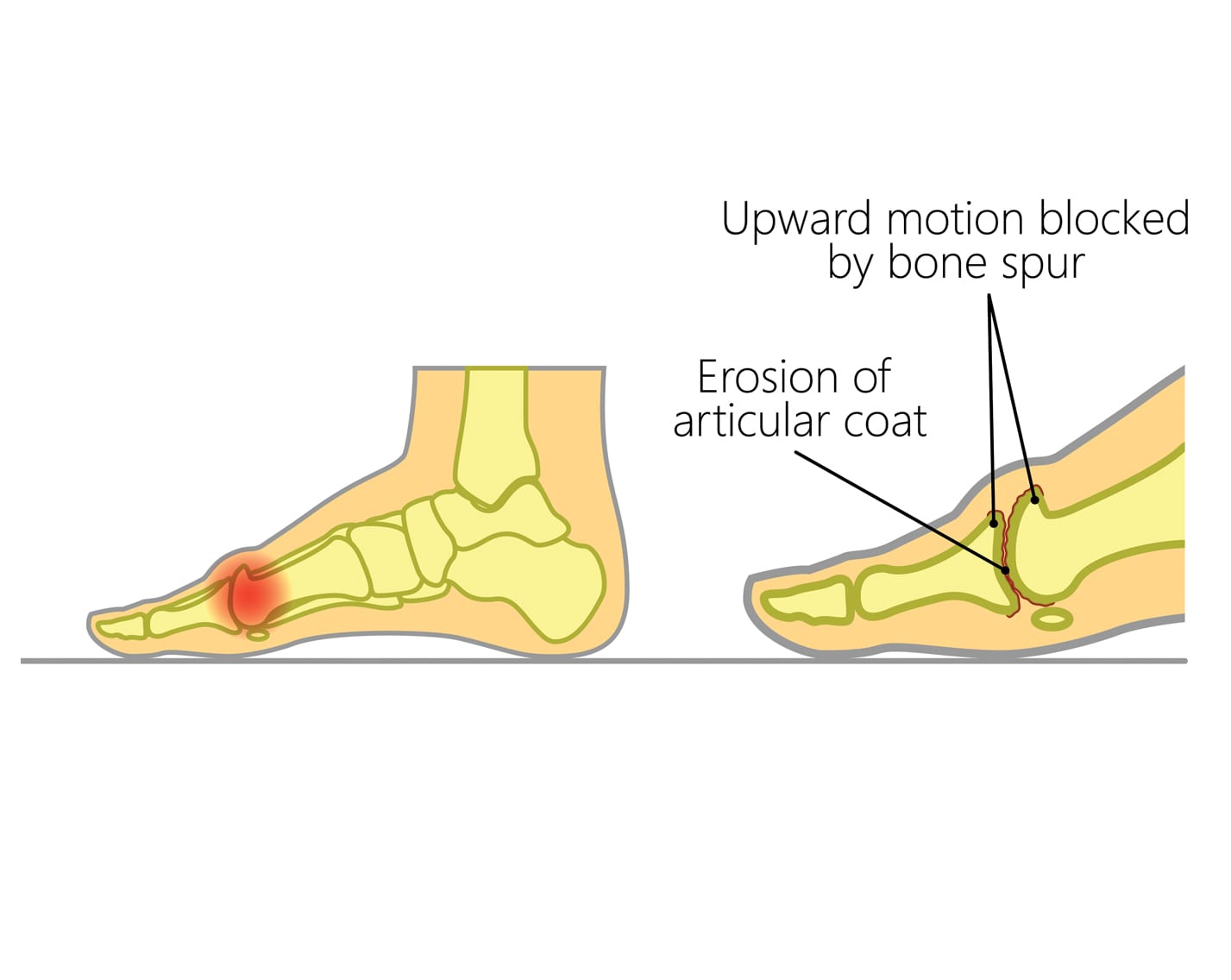Hallux rigidus, often referred to as “stiff big toe,” is a painful arthritic condition of the hallux metatarsal-phalangeal (MTP) joint (the big toe joint). The MTP joint of the big toe is the most common site in the foot affected by arthritis. Stiffness in the big toe can make walking difficult and painful. The symptoms of hallux rigidus tend to gradually worsen with activities like walking, running, and/or squatting.
Hallux Rigidus Causes, Symptoms & Treatment Options
Hallux rigidus, often referred to as “stiff big toe,” is a painful arthritic condition of the hallux metatarsal-phalangeal (MTP) joint (the big toe joint). The MTP joint of the big toe is the most common site in the foot affected by arthritis. Stiffness in the big toe can make walking difficult and painful. The symptoms of hallux rigidus tend to gradually worsen with activities like walking, running, and/or squatting.
Overview
Overview

What causes Hallux Rigidus?
The cause of hallux rigidus is usually unknown, but it is thought that the condition may be brought on by overuse and repetitive stress on the big toe from motions like squatting, often seen in baseball catchers. Arthritis of this joint can also occur after an injury that damages the cartilage of the joint, such as “turf toe.”
Hallux rigidus is most common in these sports:
• Basketball
• Baseball (most often seen in catchers)
• Softball
• Dance
• Football
• Tennis
Symptoms
The most common symptom associated with hallux rigidus are pain and swelling in the big toe joint. Other symptoms may include:
• Stiffness in the big toe that makes it difficult to walk
• A bump that develops on top of the foot and can make wearing shoes difficult
When to see a doctor
If you have pain in the big toe that makes it difficult for you to bend the toe upward and/or downward, or pain that makes it difficult to walk normally, make an appointment with an orthopedic specialist.
During your appointment, your doctor will ask you to describe your symptoms. Your doctor will then examine your foot for pain with certain motions, dorsiflexion (bending your toe upward), and plantar flexion (bending your toe downward). In the later stages of hallux rigidus, athletes are often unable to bend their toe upward. If you have pain when pressure is applied to the big toe, this may be a sign of hallux rigidus. In order to make a diagnosis, your doctor may order an x-ray to look for signs of a bone spur or arthritis.
Non-operative treatment
In minor to moderate cases of hallux rigidus, non-operative treatments can be successful in preventing or delaying the need for surgical intervention. Conservative treatments used to relieve symptoms of hallux rigidus include:
• Switching to shoes with a cushioned stiff rocker bottom sole and plenty of room in the toe box to avoid pressure on the great toe.Flip flops, shoes with flexible soles and high heels should be avoided
• Using orthotics (shoe inserts) with a semi-rigid or rigid Morton’s extension (an extension of the orthotic) that gives support to the big toe
• Nonsteroidal anti-inflammatory medication (NSAIDs), like naproxen and ibuprofen, to help relieve pain and inflammation
• Steroid injections administered by your orthopedic specialist to relieve pain and inflammation
Try these exercises to help address your condition:
Below is a PDF of the Exercise Program
Surgical Treatment
In moderate to severe cases of hallux rigidus, surgical intervention may be necessary to relieve symptoms and restore proper range of motion to the toe. The type of surgery recommended will depend on the severity of your injury. Procedures used to treat hallux rigidus include:
• Cheilectomy: For moderate cases of hallux rigidus, a cheilectomy can be performed to remove bone spurs that are causing damage to the joint’s cartilage.
• Osteotomy: In some moderate cases of hallux rigidus, a small piece of the foot bone may be removed in order to create more space for the toe to bend.
• Arthrodesis: For severe damage to the cartilage, a procedure to fuse the bones may be needed. After a fusion procedure, you will not be able to bend the toe at all but your pain will go away.
Recovery
The time it takes to recover from hallux rigidus depends on the severity of your injury and the type of treatment you receive. Following a cheilectomy, athletes can begin weight bearing and physical therapy roughly two weeks after the procedure. After more complex surgeries, like an osteotomy or an arthrodesis, it can take up to three months for the foot to heal completely.
Following any of the surgical procedures, you’ll be required to wear a special shoe or boot to protect the foot and relieve pressure from the toe. You will also need to start physical therapy in order to regain range of motion and strength of the foot.

